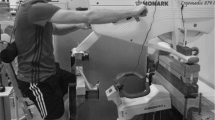Abstract
The effect in healthy elderly subjects of cycle ergometer or arm ergometer training on peak oxygen consumption (VO2peak) and ventilatory threshold (VT) was studied. The aim was to determine the benefit of each training modality on specific and cross exercise capacity. The cross-effect was also evaluated as an index of the central nature of the adaptive response to training. Twelve non-smoking healthy males (age: 67 ± 5 year; body mass: 75 ± 9 kg) were randomly divided in two age-matched groups of six, performing an arm cranking (ARM) or a cycloergometer (CYC) training (12-week, 30 min, 3 times/week), while a third group of 6 subjects (age: 73 ± 4 year; body mass: 80 ± 8 kg) performed no training (control, C). At baseline and following the intervention, subjects carried out an incremental test to exhaustion both on the ergometer on which they trained (specific test) and on the other ergometer (cross test). Respiratory variables were measured breath by breath and heart rate (HR) was recorded. Peak oxygen consumption (VO2peak), ventilation (VEpeak), oxygen pulse (O2Ppeak) and heart rate (HRpeak) were averaged over the last 10 s of exercise. Following training, while HRpeak remained unchanged, significantly higher Wpeak, VO2peak, VEpeak and O2Ppeak were obtained in both training groups, on both ergometers. The amplitude of the increase in Wpeak, VO2peak and O2Ppeak was significantly higher for specific than for cross tests (∼19% vs. ∼8 % in CYC; ∼22% vs. ∼9% in ARM, P < 0.01) while the increase in same test condition was similar. No change was observed in the C group. The results indicate that aerobic training brought about with different muscle masses, produce similar improvements in maximal and submaximal exercise capacity. Roughly half of such improvements are specific to exercise mode, which suggests peripheral adaptations to training. The other half is non-specific since it influences also the alternative exercise modality, and is probably due to central adaptations.




Similar content being viewed by others
References
Ahmaidi S, Masse-Biron J, Adam B, Choquet D, Freville M, Libert JP, Prefaut C (1998) Effect of interval training at the ventilatory threshold on clinical and cardiorespiratory responses in elderly humans. Eur J Appl Physiol 78:170–176
American College of Sports Medicine (2000) Guidelines for exercise testing and prescription, 4th edn. Lippincott Williams & Wilkins, Baltimore
American College of Sports Medicine (1998) The recommended quantity and quality of exercise for developing and maintaining cardiorespiratory and muscular fitness and flexibility in healthy adults. Med Sci Sports Exerc 30:975–991
Åstrand PO, Rodahl K, Dahl HA, Stromme SB (2003) Textbook of work physiology. 4th ed, Human Kinetics
Beere PA, Russell SD, Morey MC, Kitzman DW, Higginbotham MB (1999) Aerobic exercise training can reverse age-related peripheral circulatory changes in healthy older men. Circulation 100:1085–1094
Bhambhani YN, Eriksson P, Gomes PS (1991) Transfer effects of endurance training with the arms and legs. Med Sci Sports Exerc 23:1035–1041
Buskirk ER, Hodgson JL (1987) Aging and aerobic power: the rate of change in men and women. Fed Proc 46:1824–1829
Fabre C, Masse-Biron J, Ahmaidi S, Adam B, Prefaut C (1997) Effectiveness of individualized aerobic training at the ventilatory threshold in the elderly. J Gerontol A Biol Sci Med Sci 52: B260–B266
Fleg JL, Lakatta EG (1988) Role of muscle loss in the age-associated reduction in VO2max. J Appl Physiol 65:1147–1151
Franklin BA (1985) Exercise testing, training and arm ergometry. Sports Med 2:100–119
Franklin BA (1989) Aerobic exercise training programs for the upper body. Med Sci Sports Exerc 21:S141–S148
Frontera WR, Meredith CN, O’Reilly KP, Evans WJ (1990) Strength training and determinants of VO2max in older men. J Appl Physiol 68:329–333
Glantz SA (1997) Primer of bio statistics (Italian edition). Mc Graw Hill
Hagberg JM, Graves JE, Limacher M, Woods DR, Leggett SH, Cononie C, Gruber JJ, Pollock ML (1989) Cardiovascular responses of 70–90 yr-old men and women to exercise training. J Appl Physiol 66:2589–2594
Hellerstein HK (1978) Prescription of vocational and leisure activities. Practical aspects. Adv Cardiol 24:105–115
Hepple RT, Mackinnon SL, Goodman JM, Thomas SG, Plyley MJ (1997) Resistance and aerobic training in older men: effects on VO2peak and the capillary supply to skeletal muscle. J Appl Physiol 82:1305–1310
Janssen I, Heymsfield SB, Wang Z, Ross R (2000) Skeletal muscle mass and distribution in 468 men and women aged 18–88 yr. J Appl Physiol 89:81–88
Kohrt WM, Malley MT, Coggan AR, Spina RJ, Ogawa T, Ehsani AA, Bourey RE, Martin 3rd WH, Holloszy JO (1991) Effects of gender, age, and fitness level on response of VO2max to training in 60–71 yr olds. J Appl Physiol 71:2004–2011
Lewis S, Thompson P, Areskog NH, Vodak P, Marconyak M, DeBusk R, Mellen S, Haskell W (1980) Transfer effects of endurance training to exercise with untrained limbs. Eur J Appl Physiol 44:25–34
Loftin M, Boileau RA, Massey BH, Lohman TG (1988) Effect of arm training on central and peripheral circulatory function. Med Sci Sports Exerc 20:136–141
Magel JR, McArdle WD, Toner M, Delio DJ (1978) Metabolic and cardiovascular adjustment to arm training. J Appl Physiol 45:75–79
Makrides L, Heigenhauser GJG, Jones NL (1990) High-intensity endurance training in 20-to 30- and 60-to 70-yr-old healthy men. J Appl Physiol 69:1792–1798
Meredith CN, Frontera WR, Fisher EC, Hughes VA, Herland JC, Edwards J, Evans WJ (1989) Peripheral effects of endurance training in young and old subjects. J Appl Physiol 66:2844–2849
Ogawa T, Spina RJ, Martin WH 3rd, Kohrt WM, Schechtman KB, Holloszy JO, Ehsani AA (1992) Effects of aging, sex, and physical training on cardiovascular responses to exercise. Circulation 86:494–503
Perini R, Fisher N, Veicsteinas A, Pendergast DR (2002) Aerobic training and cardiovascular responses at rest and during exercise in older men and women. Med Sci Sports Exerc 34:700–708
Pollock ML, Miller HS, Linnerud AC, Laughridge E, Coleman E, Alexander E (1974) Arm pedaling as an endurance training regimen for the disabled. Arch Phys Med Rehabil 55:418–424
Rösler K, Hoppeler H, Conley KE, Claassen H, Gehr P, Howald H (1985) Transfer effects in endurance exercise. Adaptations in trained and untrained muscles. Eur J Appl Physiol 54:355–362
Seals DR, Hagberg JM, Hurley BF, Ehsani AA, Holloszy JO (1984) Endurance training in older men and women: I. Cardiovascular responses to exercise. J Appl Physiol 57:1024–1031
Shephard RJ (1998) Ageing, physical activity and health. 1st Italian edition, McGraw-Hill, chapter 1, p. 4
Spina RJ, Ogawa T, Kohrt WM, Martin 3rd WH, Holloszy JO, Ehsani AA (1993) Differences in cardiovascular adaptations to endurance exercise training between older men and women. J Appl Physiol 75:849–855
Stamford BA, Cuddihee RW, Moffatt RJ, Rowland R (1978a) Task specific changes in maximal oxygen uptake resulting from arm versus leg training. Ergonomics 21:1–9
Stamford BA, Rowland R, Moffat RJ (1978b) Effects of severe prior exercise on assessment of maximal oxygen uptake. J Appl Physiol 44:559–563
Stratton JR, Levy WC, Cerqueira MD, Schwartz RS, Abrass IB (1994) Cardiovascular responses to exercise: effects of aging and exercise training in healthy men. Circulation 89:1648–1655
Takeshima N, Tanaka K, Kobayashi F, Watanabe T, Kato T (1993) Effects of aerobic exercise conditioning at intensities corresponding to lactate threshold in the elderly. Eur J Appl Physiol 67:138–143
Thomas SG, Cunningham DA, Rechnitzer PA, Donner AP, Howard JH (1985) Determinants of the training response in elderly men. Med Sci Sports Exerc 17:667–672
Thompson PD, Cullinane E, Lazarus B, Carleton RA (1981) Effect of exercise training on the untrained limb exercise performance of men with angina pectoris. Am J Cardiol 48:844–850
Tordi N, Belli A, Mougin F, Rouillon JD, Gimenez M (2001) Specific and transfer effects induced by arm or leg training. Int J Sports Med 22:517–524
Visser M, Fuerst T, Lang T, Salamone L, Harris TB (1999) Validity of fan-beam dual-energy X-ray absorptiometry for measuring fat-free mass and leg muscle mass. J Appl Physiol 87:1513–1520
Wasserman K (1986) The anaerobic threshold: definition, physiological significance and identification. Adv Cardiol 35:1–23
Wenger HA, Bell GJ (1986) The interactions of intensity, frequency and duration of exercise training in altering cardiorespiratory fitness. Sports Med 3:346–356
Acknowledgements
This research was part of the project “Health is in the Movement” promoted by Comune di Verona and ULSS 20. PT was the recipient of a fellowship from CIRC (Consorzio Interuniversitario per la Ricerca Cardiovascolare), Bologna. The Authors wish to express their gratitude to all the subjects for fully complying with the testing and training programs. We are grateful to Technogym for kindly lending us the ergometers used for training. We gratefully recognize the technical assistance of Giuliana Cerutti, Doriana Rudi, Luisa Rizzi and Giacomo Giannella, in organizing the tests and supervising the training sessions.
Author information
Authors and Affiliations
Corresponding author
Rights and permissions
About this article
Cite this article
Pogliaghi, S., Terziotti, P., Cevese, A. et al. Adaptations to endurance training in the healthy elderly: arm cranking versus leg cycling. Eur J Appl Physiol 97, 723–731 (2006). https://doi.org/10.1007/s00421-006-0229-2
Accepted:
Published:
Issue Date:
DOI: https://doi.org/10.1007/s00421-006-0229-2




